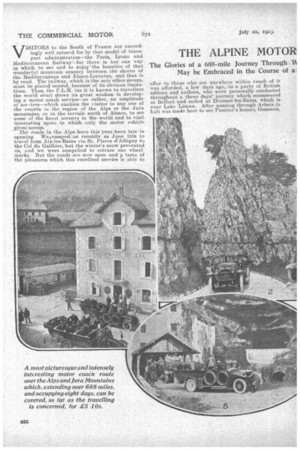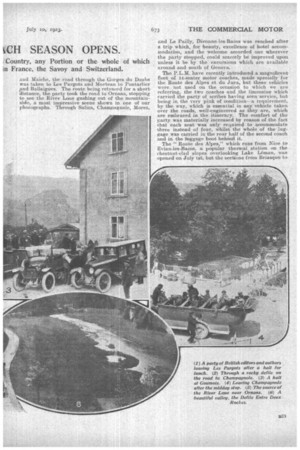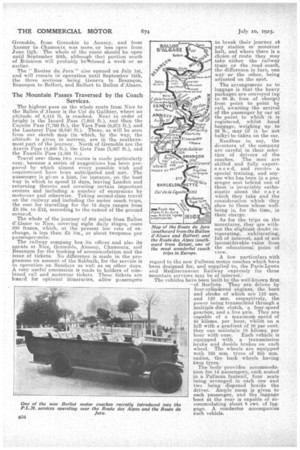• THE ALPINE MOTOR CH SEASON OPENS.
Page 16

Page 17

Page 18

If you've noticed an error in this article please click here to report it so we can fix it.
The Glories of a 688-mile Journey Through IA May be Embraced in the Course of a Country, any Portion or the whole of which in France, the Savoy and Switzerland.
VISITORS to the South of Frarice are exceedingly well catered for by that model of transport administration—the Paris, Lyons and Mediterranean Itailwayfor there is but one way in which to see and to enjoy the beauties of that wonderful mountain country between the shores of the Mediterranean and Alsace-Lorraine, and that is by road. The railway, which is the only other means, must he placed second, because of its obvious limitations. Thus, the P.L.M. (as it is known to travellers the world over) shows its great wisdom in developing a motor coach service--or rather, an amplitude of services—which enables the visitor to any one of the resorts in the region of the Alps or the Jura mountains, or in the terrain south of Alsace, to see some of the finest scenery in the world and to visit interesting spots to which only the motor vehicle ,givev.access. The roads in the Alps.have this'yearfbeen late-in opening. WeLessayed ias recently as June Eith to travel from Aix-les-Bains via St. Pierre d'Albigny to the Col du Galibier,hut the winter's snow prevented us, and. we were compelled to retrace our wheelmarks. But the roads are now open and p.. taste of the pleasures. which this excellent service is ,able to
offer to those who are anywhere within reach of it was afforded, a few days ago, to a party of British editors and authors, who were personally conducted throughout a three days' journey which commenced at Belfort and ended at Divonne-les-Bains, which is near Lake Leman. After passing through Arbois (a halt was made here to see Pasteur's house), Goumois, and Maiche, the road through the Gorges du Doubs was taken to Los Pargots and Morteau to Pontarlier And Ballaigues. The route being retraced for a short distance, the party took the road to Ornans, stopping to see the River Loue gushing out of the mountainside, a most impressive scene shown in one of our photographs. Through Salins, Champagnole, Morez, and Le Pailly, Divonne-les-Bains was reached after a trip which, for beauty, excellence of hotel accommodation, and the welcome accorded one wherever the party stopped, could scarcely be improved upon unless it be by the excursions which are available around and south of Geneva.
The P.L.M. have recently introduced a magnificent fleet of 14-seater motor coaches, made specially for the Route des Alpes et du Jura, but these vehicles were not used on the occasion to which we are referring, the two coaches and the limousine which carried the party of scribes having semi service, but being in the very pink of condition—a requirement, by the way, which is essential in any vehicle taken over the roads, well-engineered as they are, which are embraced in the itinerary. The comfort of the party was materially increased by reason of the fact that each seat was only required to accommodate three instead of four, whilst the whole of the luggage was carried in the rear hall of the second coach and in the luggage boot behind it.
The " Route des Allies," which runs from Nice to Evian-les-Bains, a popular thermal station on the chestnut-clad slopes overlooking Lake Leman, was opened on July tat, but the sections from Briancon to
Grenoble, from Grenoble to Annecy, and from Annecy to Chamonix was more, or less open from June 1511.The whole of the route should be open until September 20th although that. portion south of Briancon will probably be4closed a week or so• earlier.
The "Routes du Jura" also opened on July 1st, and will remain in operation until September 15th, the three sections being Geneva to Besancon, Besancon to Belfort, and Belfort Lb Ballon cl'Alsace.
The Mountain Passes Traversed by the Coach Services.
The highest pass on the whole route from Nice to the Ballon d'Alsace is the Col du Galibier, where an altitude of 8,415 ft. is reached. Next in order of height is the Izoard Pass (7,945 ft.), aiid then the Cayolle Pass (7,760 ft.), the Vars Pass (6,975 ft.), and the Lauteret Pass (6,840 ft.). These, as will be seen from our sketch map (in • which, by the way, the altitude is giveu in metres), are in the southernmost part of the journey. North of Grenoble are the Aravis Pass (4,950 ft.), the Gets Pass (3,867 ft.), and the Faucille Pass (4,365 ft.).
Travel over these two routes is made particularly easy, because a series of Suggestions has been prepared by which almost every possible wish and requirement have been anticipated and met. The passenger is given a hint, for instance, on the best way in which to spend 15 days, leaving London and . returning thereto and covering certain important centres and includinga number of excursions by motorcar and otherwise. Taking second-class travel an the railway and including the motor eoach.trips, the east for travelling for the 15 days ranges from 28 10s. to 212, according to the extent of the ground covered.
The •whoie of the journey of 688 miles from Ballon &Alsace to Nice, covering eight daily stages, eosts 393 francs, which, at the present. low rate of exchange, is less than 25 10s., or about twopence per passenger-mile.
The railway company has its offices and also its agents at Nice, Grenoble, Annecy, Chamonix, and Besancon for the booking of accommodation and the issue of tickets. No difference is made in the programme on amount of the Sabbath; for the service is in operation on Sundays as well as on other days. A very useful concession is made to holders of coma bined rail and 'motorcar tickets. These tickets are iesued. for optional itineraries, allow p.Issengers
to break their journey at any station or motorcar halt, and where there is a choice of route they may take either the railway train or the road coach, the difference in fare, one way or the other, being adjusted on the spot.
The arrangement as to luggage is that the heavy packages are conveyed (up to 66 lb. free of charge) from point to point by rail, awaiting the arrival of the passenger by car at' the point to which it is registered, whilst hand baggage., weighing up to 22 lb., may (if it be not bulky) be taken on the car.
Needless to say, the directors of the company are careful in their selection of drivers of the coaches. The men are skilled and fully experience d, and receive o, special training, and anyone who has been in a passenger seat behind one of them is invariably enthusiastic about the care Which they take and the consideration which they show to those whose wellbeing is, for the time, in their charge..
As for the trips on the mountains, they are without the slightest doubt invigorating, exhilarating; kill of interest, and of not inconsiderable value from the educational point of view.
A few particulars with regard to the new Pullman motor coaches which have been designed for, and supplied to, the Paris-Lyons and Mediterranean Railway expre'ssly for these mountain services may be of interest.'
The vehicles have been built by the well-known firm of Berliets.. They are driven by four-eylindered engines, the bore and stroke of which are 110 mm. and 140 min. respectively, the power being transmitted through a multiple disc clutch, a four-speed gearbox, and .a live axle. They are cap-able of a maximum speed of 45 kiloms. per hour, whilst on a hill with a gradient of 10 per cent. they can maintain 18 kiloms. per hour with .ease. Each vehicle is equipped -with a transmission brake and double brakes on each wheel. The wheels are equipped with 155 mm. tyres of 955 mm. radius, the back wheels having twin tyres.
The body provides accommodation for 14 passengers, eacll seated. in a Pullman fauteuil, four seats being arranged in each row and two being disposed beside the driver. Ample room is -given to each passenger, and the luggage boot at the rear is capable of accommodating about 8 cwt. of lug.. gage. A conductor accompanies each vehicle.




























